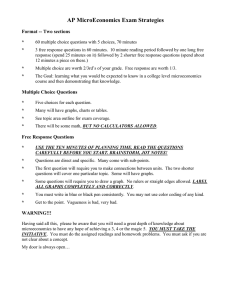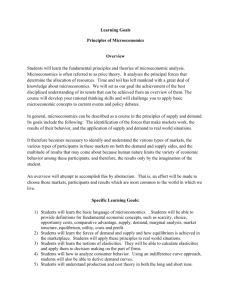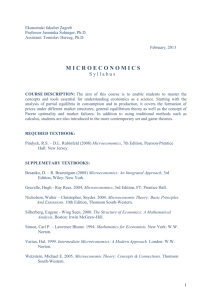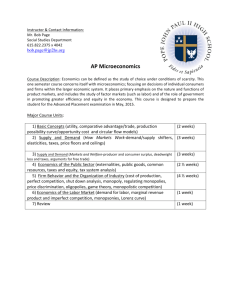Most households today are familiar with he term microeconomics
advertisement
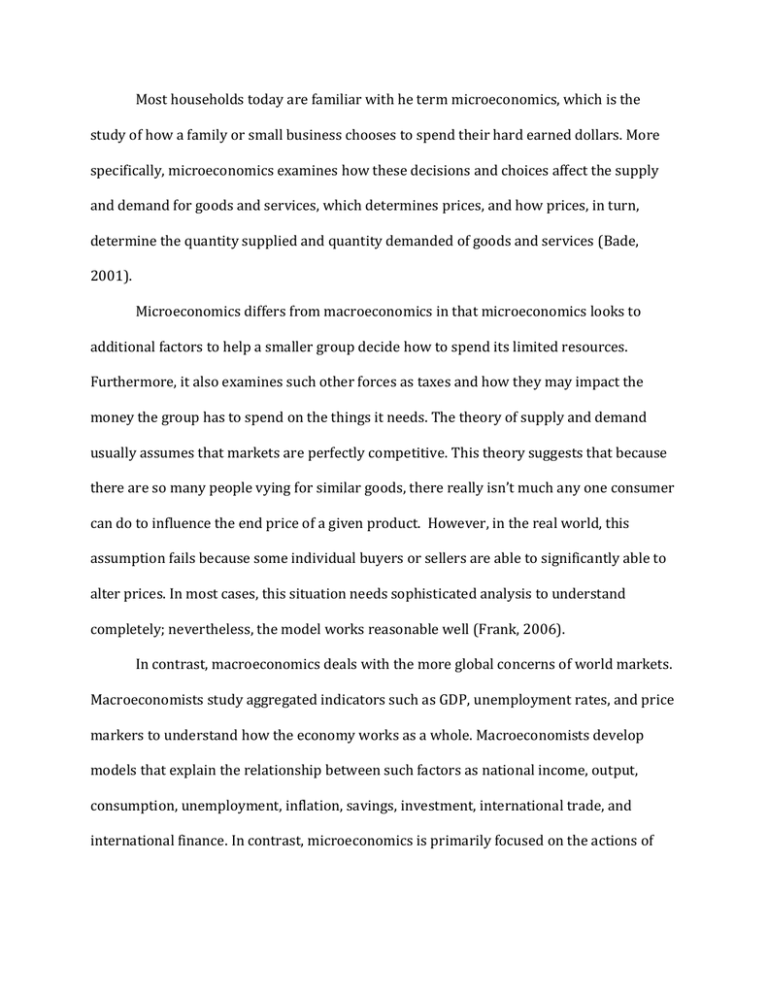
Most households today are familiar with he term microeconomics, which is the study of how a family or small business chooses to spend their hard earned dollars. More specifically, microeconomics examines how these decisions and choices affect the supply and demand for goods and services, which determines prices, and how prices, in turn, determine the quantity supplied and quantity demanded of goods and services (Bade, 2001). Microeconomics differs from macroeconomics in that microeconomics looks to additional factors to help a smaller group decide how to spend its limited resources. Furthermore, it also examines such other forces as taxes and how they may impact the money the group has to spend on the things it needs. The theory of supply and demand usually assumes that markets are perfectly competitive. This theory suggests that because there are so many people vying for similar goods, there really isn’t much any one consumer can do to influence the end price of a given product. However, in the real world, this assumption fails because some individual buyers or sellers are able to significantly able to alter prices. In most cases, this situation needs sophisticated analysis to understand completely; nevertheless, the model works reasonable well (Frank, 2006). In contrast, macroeconomics deals with the more global concerns of world markets. Macroeconomists study aggregated indicators such as GDP, unemployment rates, and price markers to understand how the economy works as a whole. Macroeconomists develop models that explain the relationship between such factors as national income, output, consumption, unemployment, inflation, savings, investment, international trade, and international finance. In contrast, microeconomics is primarily focused on the actions of individual people, such as families, small business, and consumers, and how their buying choices determine overall prices and quantities in specific markets (Blaug, 1985). The corporation, GilbertRussell (GR), is concerned with the current status of the economy. Their fears are well grounded in these troubling economic times. However, there are some glimmers of hope on the horizon that may help GR is the coming lean months. Careful attention to detail as well as a trimming of their financial outlays may help them. These are microeconomic concepts, and include determining how GR has been spending money in the good times, but looking to save money in the lean times. For example, GR should consider its current outlays for employee expenses and see if there is any ways in which this pending may be cut. Possibly some in their staff may wish to take an elective early retirement for a small payment now to help GR save money in salary in the future. In addition, GR may wish to examine their spending practices for their monthly bills, such as various utilities. Nowadays, many phone services are offering scaled back plans to help smaller companies maintain their edge in the tough money crunch. Larger utility organizations are offering incentives to small companies who choose not to switch to cheaper competitors. Whatever the choice, all of these steps may help GR save some of the money, especially at this critical time. It is probably in GR’s best interest to choose goods and services for their own use that are the most fiscally sound. All unnecessary expenditures should be discontinued for the time being, and employee raises should be put on hold until the country’s financial situation improves. These may seem to be drastic measures to take, and may in fact be difficult to implement. Nevertheless, this makes the best financial sense in these uncertain times. Microeconomics, such as what we are suggesting to GR, affects goods and services, efficiency, equity, the market economy, and the modern mixed economy. The modern mixed economy is one that combines both the use of markets and significant government presence in economic decision-making. In other words, much of the choices being made by small business such as GR are being influenced by significant government involvement. Even large and well-known companies are looking to the US government to help bail them out of the economic mess they may be experiencing now. However, smaller options that are being made by consumers are driving how much goods are being used and needed. If people decide they do not want to spend money on gas guzzling automobiles, car companies will be forced to listen and produce smaller and more efficient cars. The same may be said for small business as well. GR may decide to use different and more economical ways to produce their products that may trickle to their suppliers down the line. Making these careful decision now can only position GR in a place of real advantage among their competitors. As GR elects to be more resourceful, they can pass their savings on to the consumers. This will likely cause demand to change too, as customers will be looking for better deals and saving more money. Even when the economy returns to a strong point, it is likely that many will recall these tighter times and continue with their economic ways. References Bade, R. (2001). Foundations of Microeconomics. Addison Wesley Paperback 1st Edition. Blaug, M. (1985). Economic theory in retrospect, Cambridge, UK: Cambridge University Press. Frank, R. (2006) Microeconomics and Behavior. McGraw-Hill/Irwin, 6th Edition: 2006.

